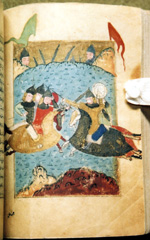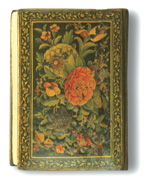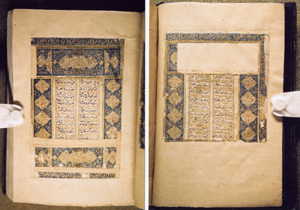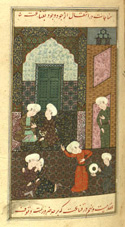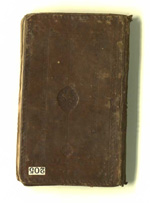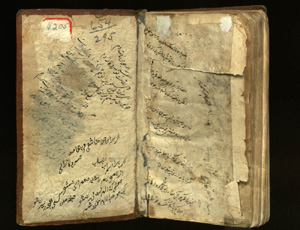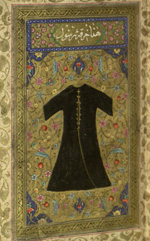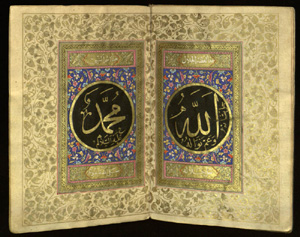IRANICA: PRESERVATION: CATALOGUE
Cat. No. 11
Khamsa [Quintet] of Nizami
Shiraz, early 15th century
Ink, colors, and gold on paper ; 19th-century lacquer binding
Binding size : 11 x 7.8 cm
This diminutive manuscript bears many signs of its use over the centuries: text pages are stained and smeared, many of the paintings' finest details have flaked off, the binding has been replaced, and, in some cases, whole blocks of script and narrative illustration have been excised and remounted onto new sheets of paper. That this rare Persian manuscript remains intact is likely due, in part, to its size, which made it ill-suited for dismemberment and sale by individual painting - a practice that was quite common from the nineteenth to the twentieth century.
Cat. No. 12
Collection of didactic verse; Ni'matullah bin Reenu al-Abadeen Rud Bari, calligrapher
Tabriz, A.H. 934 (1527/28 C.E.)
Ink, colors, and gold on paper; stamped leather binding
Binding size: 20.9 x 12.7 cm
This small, illustrated text differs greatly from the celebrated Shah Tahmasp Shahnameh ('Book of Kings'), even though both manuscripts were produced in Tabriz, Iran, at around the same time. Containing only two paintings - compared to the Shahnameh's 258 - this collection of didactic verse would have interested early twentieth-century scholars and students of Islam more that it would have art collectors. Today, this book remains complete, while the Shah Tahmasp Shahnameh is divided among a number of museum and private collections.
Cat. No. 13
Devotional miscellany; Mustafa [Kütahi], calligrapher
Ottoman Empire, A.H. 1185 (1771/1772 C.E.)
Ink, colors, and gold on paper
Paper size: 17.4 x 11.8 cm
Gift of Blanche Wolf Kohn '08
Unlike the other works in this exhibit, ths handsome prayer book hails from the Ottoman Empire, most likely from Istanbul. As appreciation for Ottoman book arts among Western collectors has long lagged behind that for Persian painting, the inclusion of this manuscript among Blanche Wolf Kohn's possessions (later gifted to Bryn Mawr College) attests to the unique collecting habits of those whose tastes extended beyond popular preferences.
